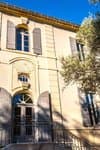
MAUSSANE LES ALPILLES - Towards Les-Baux-de-Provence
Discover the olive crops classified as AOC, the many irrigation canals, stone built houses, a cave house ... the route passes under the rocky outcrop of Baux which looks like a boat prow close up and from far, it remains a stunning view. The scrubland reveals a quite unusual scenery of Provence, with its "baou trouca" pierced rocks. The trail ends by crossing the old Maussane and passing through the village center.
9 points of interest
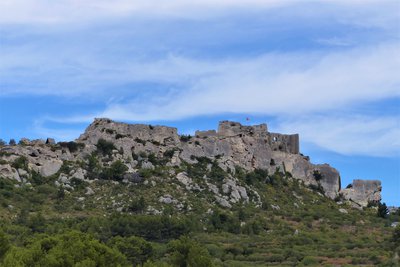
Château des Baux-de-Provence - ©Rémi Sérange - PNR Alpilles  Panorama
PanoramaCastle of Baux-de-Provence
Between vineyards and olive trees, stands the castle of Baux-de-Provence. The oldest remains of the medieval castle of Les Baux date back to the 12th century. On the same date, the village around the castle already existed, with its few streets, its houses partly troglodytes (dug in the rock) and its two churches: Saint-Vincent in the middle of the houses on the spur and Saint-André with its cemetery at the foot of the slope.
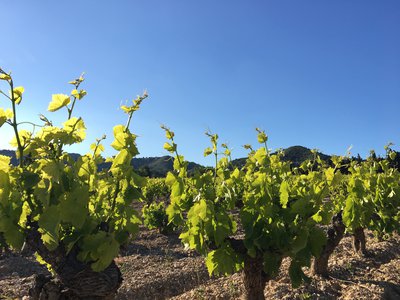
Vignes AOP des Baux-de-Provence - ©Office de tourisme des Baux-de-Provence  Produits du terroir
Produits du terroirAOP Les Baux-de-Provence
The Protected Designation of Origin "Les Baux-de-Provence" was obtained for the wines, in 1995. It now includes 12 producers who cultivate 350 hectares of vineyards on the northern and southern slopes of the Alpilles, for an annual production of 9,000 hectolitres. This production is obtained 85% in organic farming. The producers are also willing to include this specificity as a mandatory criterion, so as to become the first organic PDO wine in France.
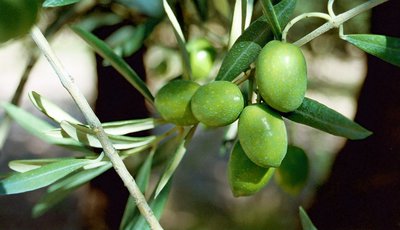
Olives AOP des Baux-de-Provence - ©Office de tourisme des Baux-de-Provence  Produits du terroir
Produits du terroirPDO Valley des Baux-de-Provence
In respect of olives and olive oils, the protected designation of origin "Valley of Baux-de-Provence" is today the symbol of quality. It was obtained on August 31, 1997 for three products: broken green olives, pitted black olives and olive oil. The olive trees bathed in the Provencal sun produce "Ardente" olive oils with fruity aromas. To note : olive oil from the Baux-de-Provence Valley currently accounts for 30% of national production!

Baou trouca, rochers troués - ©Marianne Dispa - PNR Alpilles  Geology
GeologyThe holed rocks
The baou troucas or holed rocks can be observed from the track. Looking up, you will notice an irregular calcareous rock, with numerous holes.
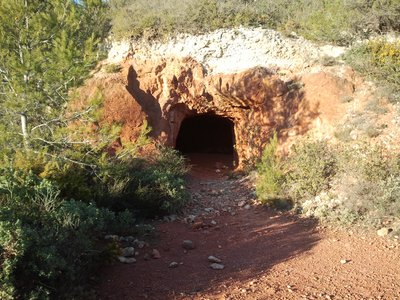
Entrée d'une galerie de bauxite - ©Marianne Dispa - PNR Alpilles  Geology
GeologyRed ground
Bauxite, named after the Baux-de-Provence, is a mix of clay, aluminum oxide and iron oxide, generally red but sometimes tiger or whitish color, depending on the iron oxide and impurity content.
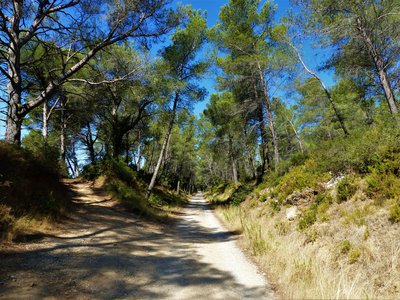
Tracé de l'ancienne ligne ferroviaire - ©Rémi Sérange - PNR Alpilles  Patrimony and history
Patrimony and historyOld railway line
Started in 1868, the construction of the Arles-Salon railway line was completed in 1887. In 1900, a traffic evaluation shows that the number of passengers and goods (cereals, wine, coal) is small. Although the prosperity of the villages benefited from connection to the rail network, the line was finally closed in 1950, in a context favorable to road traffic.
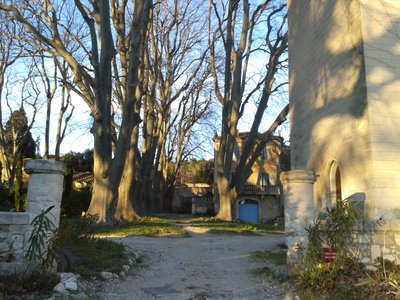
Château de l'Escanin - ©Marianne Dispa - PNR Alpilles  Patrimony and history
Patrimony and historyCastle of Escanin
The estate of the Escanin Castle is surrounded by ancient plane trees. A chapel of the 18th century is hidden inside.
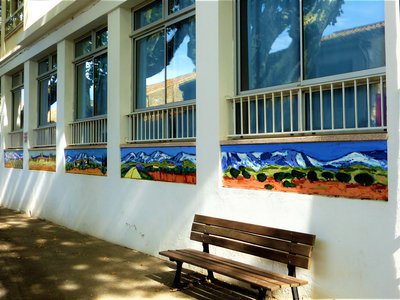
Moitié gauche de la fresque de Jean-Claude Quilici - ©Rémi Sérange - PNR Alpilles  Patrimony and history
Patrimony and historyMural by Jean-Claude Quilici
This mural was realized in 2014 by 35 students under the mentorship of the artist Jean-Claude Quilici. The latter is a painter of Corsican origin, born in Marseille in 1941, who has a workshop in Maussane-les-Alpilles. Specialized in Provencal painting, he exhibited in the largest French, American and Japanese galleries. ;Among other things, he has created a 40m by 4m mural for the University of Corte and a 130m long mural for the Marseille metro.
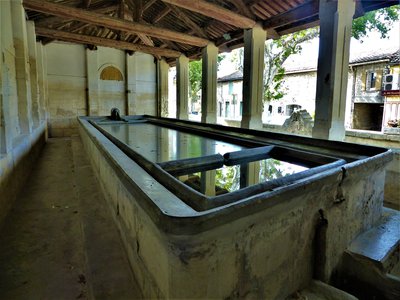
Intérieur du lavoir Napoléon III - ©Rémi Sérange - PNR Alpilles  Water and rivers
Water and riversNapoleon III wash house
This Second Empire wash house style (Napoleon III), was inaugurated on March 26, 1865, after having been realized by the Avignon architect Louis Astruc. The inhabitants of the town came there to do their laundry, making an important social meeting place. For the period this wash house presented a great particularity : It allowed to do the laundry standing, and no longer on the knees. ;
Description
Back to the Tourist Office, cross the parking lot and turn left on the CD5.
1 - Take the first left, pass the municipal pool and after the small town square, go left. At the give-way, turn right. At the exit of Maussane (road sign), pass under the aqueduct and turn right on the road between the golf course and the foothill. Follow this paved road, cross the golf course to the cattle guard.
2 - Head to the left track. In front of the boulders, leave behnd the 2nd cattle guard on the left and turn right. 50m further, go left at the start of the 18th hole. While the track goes off to the left, reach the D27 by the small road along the stone wall. Opposite Baumanière, take a right onto the D27 for 50m.
3 - Go left towards the retirement home. Continue on the road for 150m and turn left into the alley between the houses. At the next intersection, turn right, go up the trail until reaching and going along a stone wall. At the curve, go straight, go slightly up the forest track to the left. Go down and reach the D78F road.
4 - Cross the D78F then go down the opposite path. Walk along the canal to the left towards Le Paradou. At the junction of 5 roads, continue straight on the road with the oratory under Aleppo pine.
5 - Come out on the D78d, then turn right for 50m. At the oratory, turn left into the Chemin de Bourgeac. After 600m, turn left to the Méjan domain. After the olive groves, turn right onto the path that dominates the village. Facing the black metal gate, go down to the right towards the village. At the stop sign, cross the Avenue Cornille and enter the village on the opposite side. Turn left at the end of the street, then walk past the town hall, the church and the Place du Marché. After the Avenue Baptiste Blanc, go left onto the D5 to reach the car park from the start.
- Departure : House of Tourism, Maussane-les-Alpilles
- Arrival : House of Tourism, Maussane-les-Alpilles
- Towns crossed : Maussane-les-Alpilles, Les Baux-de-Provence, Fontvieille, and Paradou
Forecast
Altimetric profile
Recommandations
For safety issues and for the preservation of forests, access to natural areas is regulated from June to September. Get information during the summer at 08 11 20 13 13 (cost of a local call), on www.bouches-du-rhone.pref.gouv.fr, or the free application MYPROVENCE ENVIE DE BALADE (available on App Store and Android Market).
Information desks
House of the Alpilles Regional Nature Park
2, boulevard Marceau, 13210 Saint-Rémy-de-Provence
Located in the heart of the city centre of Saint-Rémy-de-Provence, the House of the Alpilles Nature Park welcomes you to its completely renovated premises. This new vibrant place is multifunctional: it accommodates the Park's engineering team but also has a public reception space and showrooms. A true resource centre of the Park's heritage, it aims to support and promote locals, visitors and tourists on all 16 municipalities of the Park.
Open Monday to Friday, from 9 am at 12:30 pm and from 1:30 pm to 5 pm.
Free admission.
OT Maussane-les-Alpilles
Avenue des Alpilles, 13520 Maussane-les-Alpilles
Transport
Public transport timetables are available at www.lepilote.com
Access and parking
At 10km south-southwest of St-Remy-de-Provence through the D5. Follow the "Maison du Tourisme" indications.
Parking :
Report a problem or an error
If you have found an error on this page or if you have noticed any problems during your hike, please report them to us here:

